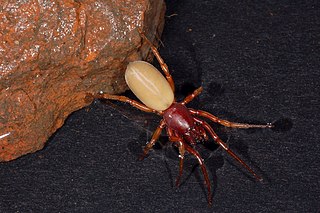
The Thomisidae are a family of spiders, including about 170 genera and over 2,100 species. The common name crab spider is often linked to species in this family, but is also applied loosely to many other families of spiders. Many members of this family are also known as flower spiders or flower crab spiders.

Dysderidae, also known as woodlouse hunters, sowbug-eating spiders, and cell spiders, is a family of araneomorph spiders first described by Carl Ludwig Koch in 1837. They are found primarily in Eurasia, extending into North Africa with very few species occurring in South America. Dysdera crocata is introduced into many regions of the world.

The Goliath birdeater belongs to the tarantula family Theraphosidae. Found in northern South America, it is the largest spider in the world by mass and body length, and second to the giant huntsman spider by leg span. It is also called the Goliath tarantula or Goliath bird-eating spider; the practice of calling theraphosids "bird-eating" derives from an early 18th-century copper engraving by Maria Sibylla Merian that shows one eating a hummingbird. Despite the spider's name, it rarely preys on birds.
William Syer Bristowe, who wrote under the name W. S. Bristowe, was an English naturalist, a prolific and popular scientific writer and authority on spiders. He was educated at Wellington College and Cambridge University and in 1921 went on a Cambridge University expedition to Jan Mayen led by James Mann Wordie. Two years later he went on another Cambridge University expedition, this time to Brazil.

Nepenthesinfauna are the organisms that inhabit the pitchers of Nepenthes plants. These include fly and midge larvae, spiders, mites, ants, and even a species of crab, Geosesarma malayanum. The most common and conspicuous predators found in pitchers are mosquito larvae, which consume large numbers of other larvae during their development. Many of these animals are so specialised that they cannot survive anywhere else, and are referred to as nepenthebionts.
Henriksenia nepenthicola, synonym Misumenops nepenthicola, is a species of crab spider. It is native to Singapore. It lives inside the pitchers of a number of lowland Nepenthes pitcher plants. As such, it is classified as a nepenthephile. They are slow-moving spiders which do not actively hunt. Males and females both reach a length of 6 mm.

Nepenthes madagascariensis is one of two Nepenthes pitcher plant species native to Madagascar, the other being N. masoalensis.

Bristowia is a genus of spiders in the jumping spider family, Salticidae, found in Africa and Asia.

Pseudicius is a genus of the jumping spiders first described by Eugène Simon in 1885. The name is combined of Greek pseudo "false" and the salticid genus name Icius. The small genus Wesolowskana should possibly be included in this genus. There is some dispute whether Afraflacilla is a distinct genus or should be included in Pseudicius. Festucula and Marchena are other close relatives, these genera form a monophyletic group.

Frederick Octavius Pickard-Cambridge was an English arachnologist. He is sometimes confused with his uncle, Octavius Pickard-Cambridge (1828–1917), who was also an arachnologist and from whom F. O. Pickard-Cambridge picked up his enthusiasm for the study of spiders.
Microhyla borneensis, also known as the Matang narrow-mouthed frog, is a species of microhylid frog found in the Matang Range in Sarawak, Borneo. It was once the smallest known frog from the Old World. Adult males of this species have a snout-vent length (SVL) of 10.6–12.8 mm (0.42–0.50 in), but adult males can reach a maximum of 13 mm (0.51 in),and adult females of this species have a snout-vent length of 16–19 mm (0.63–0.75 in), Tadpoles measure just 3 mm.

Savarna is a genus of Southeast Asian cellar spiders that was first described by B. A. Huber in 2005.

Michèle Striffler is a French politician who served as a Member of the European Parliament (MEP) for the East constituency from 2009 to 2014.

Spiders are air-breathing arthropods that have eight legs, chelicerae with fangs generally able to inject venom, and spinnerets that extrude silk. They are the largest order of arachnids and rank seventh in total species diversity among all orders of organisms. Spiders are found worldwide on every continent except for Antarctica, and have become established in nearly every land habitat. As of August 2022, 50,356 spider species in 132 families have been recorded by taxonomists. However, there has been debate among scientists about how families should be classified, with over 20 different classifications proposed since 1900.

Artema is a genus of cellar spiders that was first described by Charles Athanase Walckenaer in 1837.
Vinathela is a genus of spiders in the family Liphistiidae. It was first described in 2000 by Ono. As of 2017, it contains 7 species. Two species were formerly placed in the genus Nanthela, now submerged into Vinathela.
Henriksenia is a genus of crab spiders that was first described by Pekka T. Lehtinen in 2004.

Pycnaxis is a genus of Asian crab spiders first described by Eugène Simon in 1895. They are endemic to eastern Asia from China to the Philippines.<ren name=NMBE />
Labahitha is a genus of crevice weavers that was first described by S. L. Zonstein, Yuri M. Marusik & I. L. F. Magalhaes in 2017.
Misumenops nepenthicola can refer to two species of spider:












